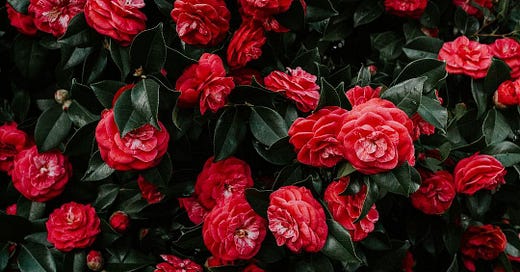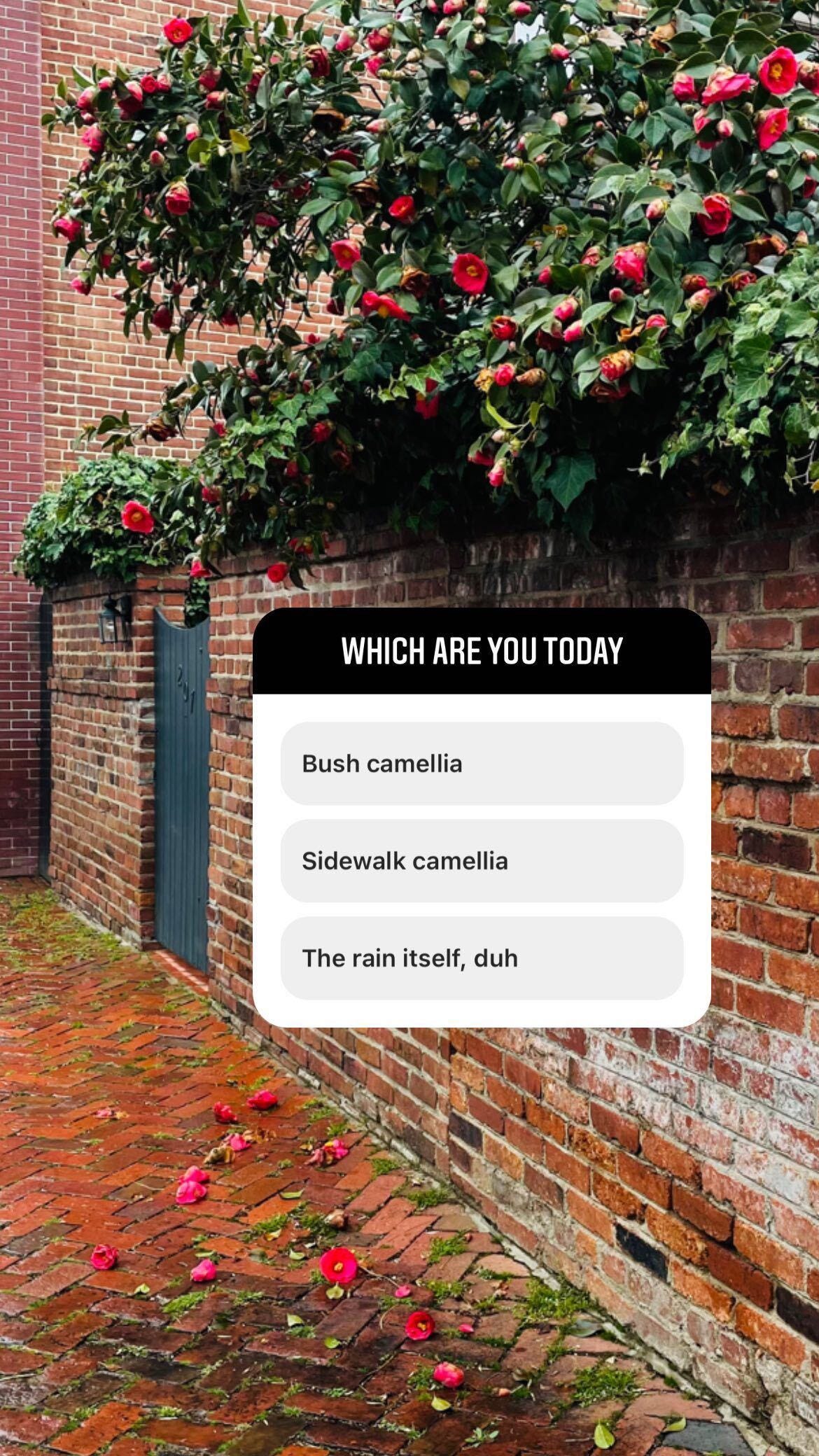Camellia Feels
Dear Friends,
A few weeks ago, I posted a photo to my Instagram stories with this joke of a poll:
Which are you today?
A: Bush camellia
B: Sidewalk camellia
C: The rain itself (duh)
The results from my friends, if you’re curious, were 44% for sidewalk camellia, 37% for the rain, and 19% for bush camellia, which tells me plenty about our current state of being.
“I want to be the rain,” one friend wrote to me, “but I’m definitely the petals wilted on the sidewalk.”
“I feel this in a huge way,” I wrote back. “I want to be devastating, but instead I am devastated.”
I like this photo and metaphor in part because it’s so precise–the camellias are beautiful whether they’re thriving on the bush or wilting on the ground. Sometimes we know we’re supposed to be flowers, but instead we feel like A Force. But I also like it because it serves as a good reminder of how temporary feelings can be. The rain eventually stops. The camellias on the bush will soon have their turn on the ground. Next year, we will all bloom again.
It sometimes feels impossible in the midst of uncertainty, but I’ve been trying to categorize feelings as things that are impermanent and not some theme of the larger narrative of my life.
This has been the longest winter ever.
It’s been a hard year.
Actually, maybe I haven’t been happy since 2015??
Writer Haley Nahman calls this tendency an “elastic mood”--when a feeling is so overwhelming that you mistake its intensity for longevity.
“If the anxiety that you’re experiencing is profound enough, it can feel all-encompassing, as if you’ve felt that way forever,” Nahman writes. Have you caught yourself saying things like “it’s been a really hard month” when actually you felt happy and calm just a few days ago? No feeling lasts forever. It might help to…well, check yourself. Sidewalk camellia is not, it turns out, LIFE.
I’ve been doing something kind of neurotic, but helpful, lately: marking bad or intense days on the calendar in my phone. The day I fell down the stairs and hurt my knee. The day my daughter had a fever. The day my mom had surgery. This helps me to mark distance from these moments–to compare how I’m feeling now to how I felt on that day. Even when an old worry fades away and is replaced by a new one, it’s helpful for me to note the shift to something different, rather than label everything a continuation of the same hard time.
I suppose a technique that could be more intentional (and balanced) would be keeping a journal–even just one to track moods. To be fair, I also make note of my camellia-on-the-bush days, usually through my mindful photography practice or, again, a simple calendar entry.
I’ve also noticed an interesting shift these last few months–in the lull after the Omicron wave, my feelings have been tied less often to external situations and more to how I’m feeling in my body.
There’s a James Clear quote I like: ”Everything is downstream from how your body is functioning.” I think he meant this to be about exercise–if you don’t get your workout in, everything else feels harder (anxiety, lethargy, etc.). In my healthiest times, I agree. But I think this especially applies to less-well times and how our bodies affect our feelings.
When I’m sick, when I’m injured–these are the prime times I fall victim to the elastic mood. Suddenly, I’ve always been sick. I’ve always been unable to climb the stairs. I’ll never feel happy again. This is also the thing that scares me the most about chronic illness or disability, which, if you’ve been lucky enough to avoid, could strike at any time. How do we cope in our minds when our bodies suffer? What happens when feelings aren’t so temporary?
I suppose, then, one answer is to examine the view from the sidewalk. What is gone might be gone for now, or forever. But we should also acknowledge what is left. I am no longer in my peak bloom, surrounded by green leaves. My knee is still injured. I can’t ride my bike. I live in fear of my child darting away from me, because I’m uncertain if I could run after her. But I can walk again, even to the park twenty minutes away. I can respond to my daughter’s persistent requests from her high chair rather than crying every time I have to sit or stand. I may be down here on the sidewalk in the cold, but lying flat like this, I’ve got a great view of the sky.
I’m always dancing around the edges of optimism. I find it cloying, and usually a poor attempt to erase the harsh realities of human experience. But human experience is rarely all or nothing. It’s the howl of the rain, it’s the glistening drop on a petal. It’s the bruise as well as the new growth. It’s every overdone metaphor for spring, it’s here, it’s gone.
Take good care,
Dot
News & Updates
Young people have been through a lot in the past few years. Throughout the pandemic, children and teens have experienced so many different types of loss, whether that be the death of a loved one, changes within their family structure, or the loss of their old routines and feelings of safety. Does your child need some extra support? Katie Gaynor has three after-school openings for new clients ages 6-18 who have been impacted by grief, loss, or trauma, or are experiencing anxiety or depression.
Read more about Katie here, and email info@alexandriaarttherapy.com to tell us more about your family and schedule a free consultation.
Blog Posts
In our latest blog, we checked in with Adele Stuckey, Celeste Cantees, and Dot Dannenberg to see how their 100 Day Projects were going. From exploring archetypes to juggling motherhood to breaking the rules, it’s been a fascinating first 30 days.
Links We Like
What if practicing doesn’t make us better? (The Atlantic)
“...grief has become the air itself.”
Teens and mask anxiety: “Only seeing half of someone’s face for two years straight and then completely opening up to them, like, ‘Oh, here’s my face’ — you know, it’s a lot.” (NYT)
“What, pray tell, is a hydration journey, and why does my phone think I’m on one? Is it just me, or has everything become a journey? In recent days, I’ve been peddled more quests than the entire Star Wars franchise, all in the name of ‘betterment.’ A fitness journey. A wellness journey. A skincare journey. A meditation journey. A hair-growth journey. A home renovation journey. And my least favorite, a weight loss journey. Even the act of drinking water — a literal necessity, along with air and food and sleep — is being marketed like it’s some kind of makeover.”
And for journeys I can get behind (and can’t stop thinking about), I found Cheryl Strayed’s previously-cut excerpt from the first draft of Wild incredibly compassionate and compelling. (TW: addiction, drug use).
Four truths partners of stay-at-home-parents need to understand.
What pandemic habits do you want to release? What do you want to keep? (NYT)
Is it ever too late to become an artist? This book looks so good.
How to support a child on the Transgender spectrum. (NYT)
“I’m still crying. The end point is not no crying. I’ll be crying from here on out. Just a little every day. And honestly feeling a little bolder every day, too. Because what if we’ve been trying to cope wrong, holding it in, just getting over it, not crying because things could be worse, we don’t want to scare or trouble anyone, not grieving too much as to be hysterical or disordered. What if our stoical coping has served the interest of someone other than ourselves?”
Camellias by Maddy Churm:







